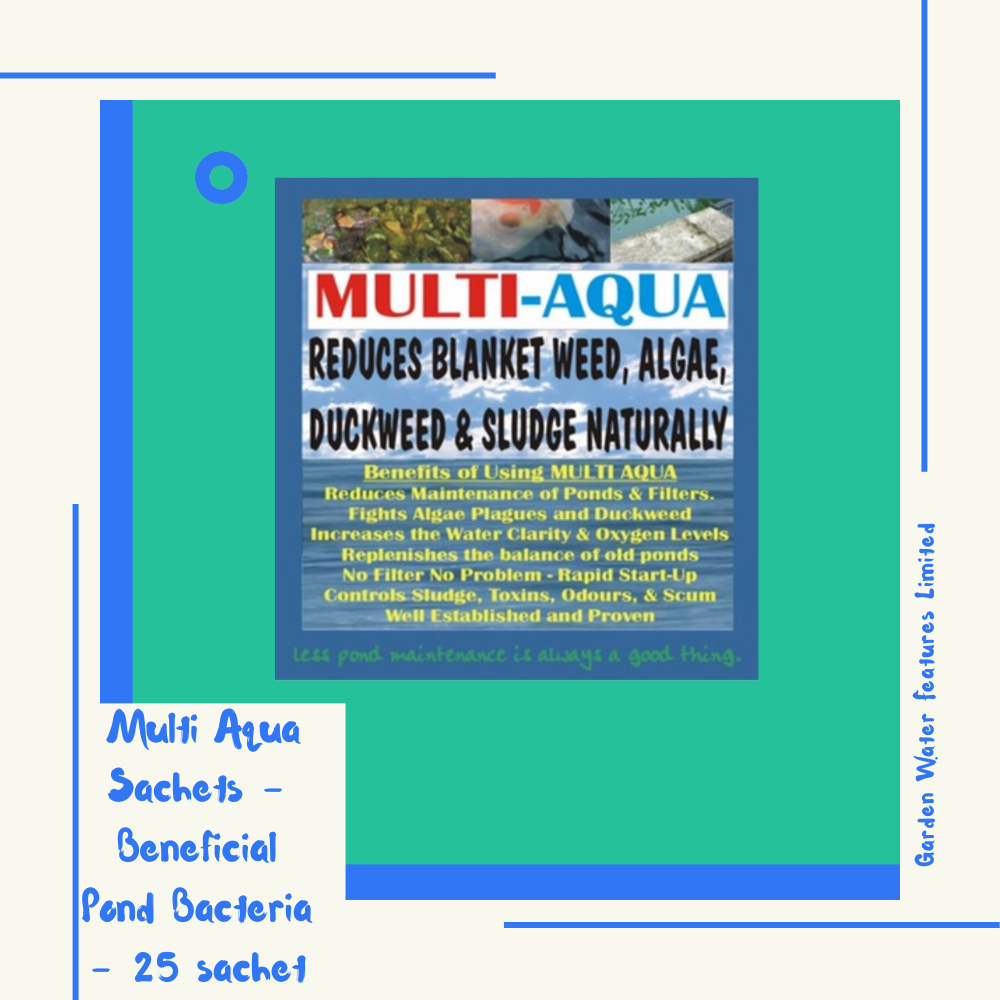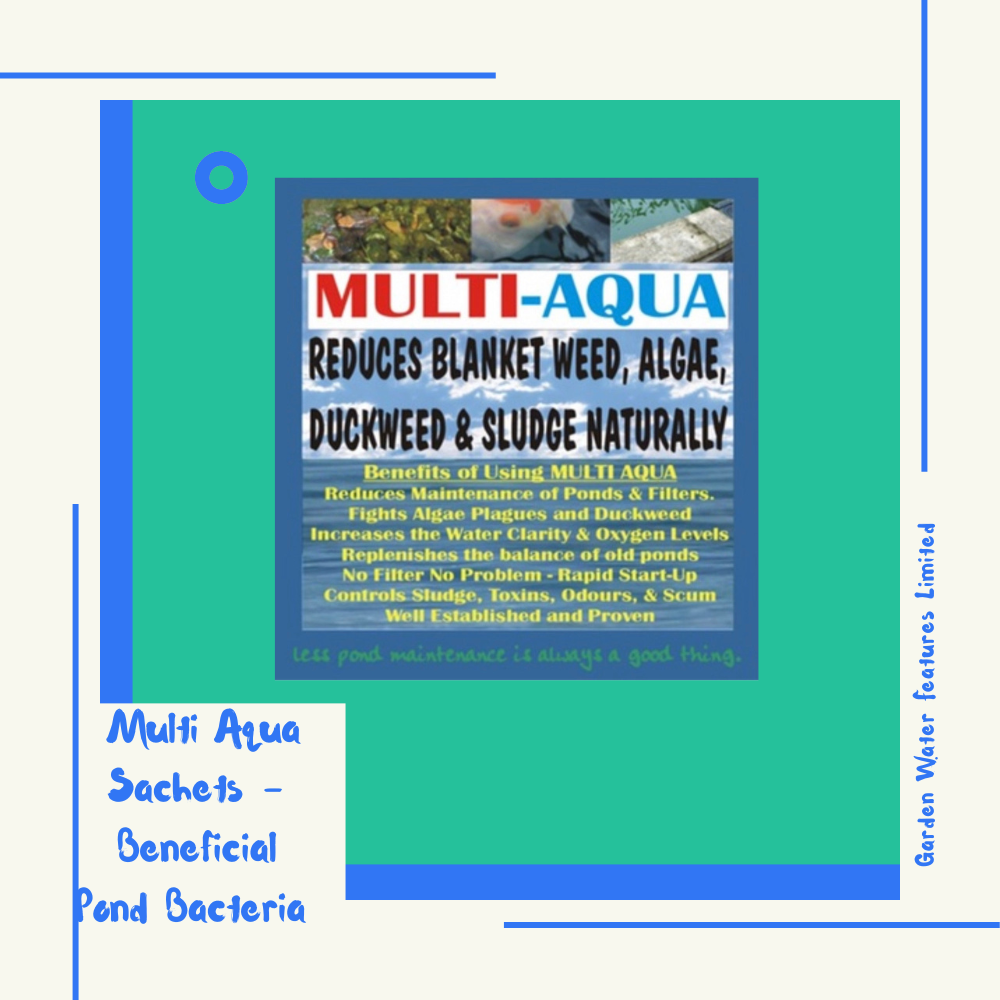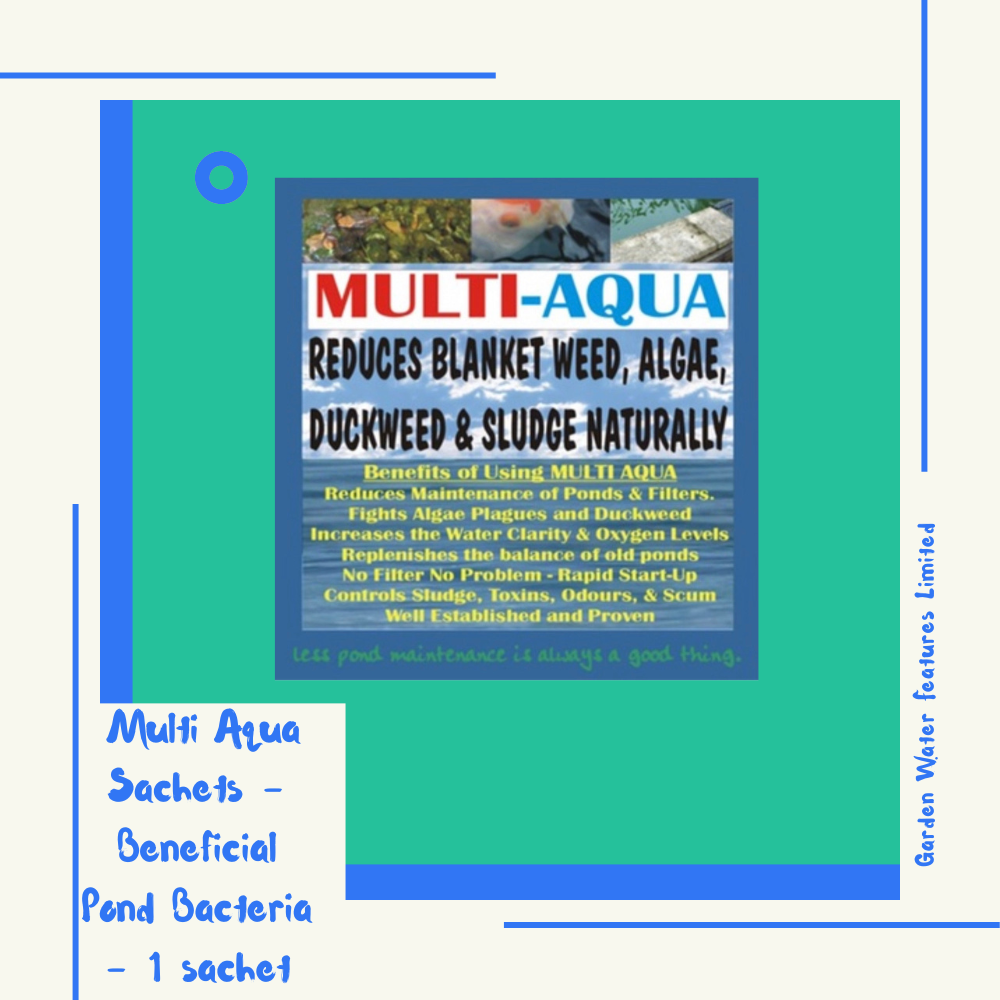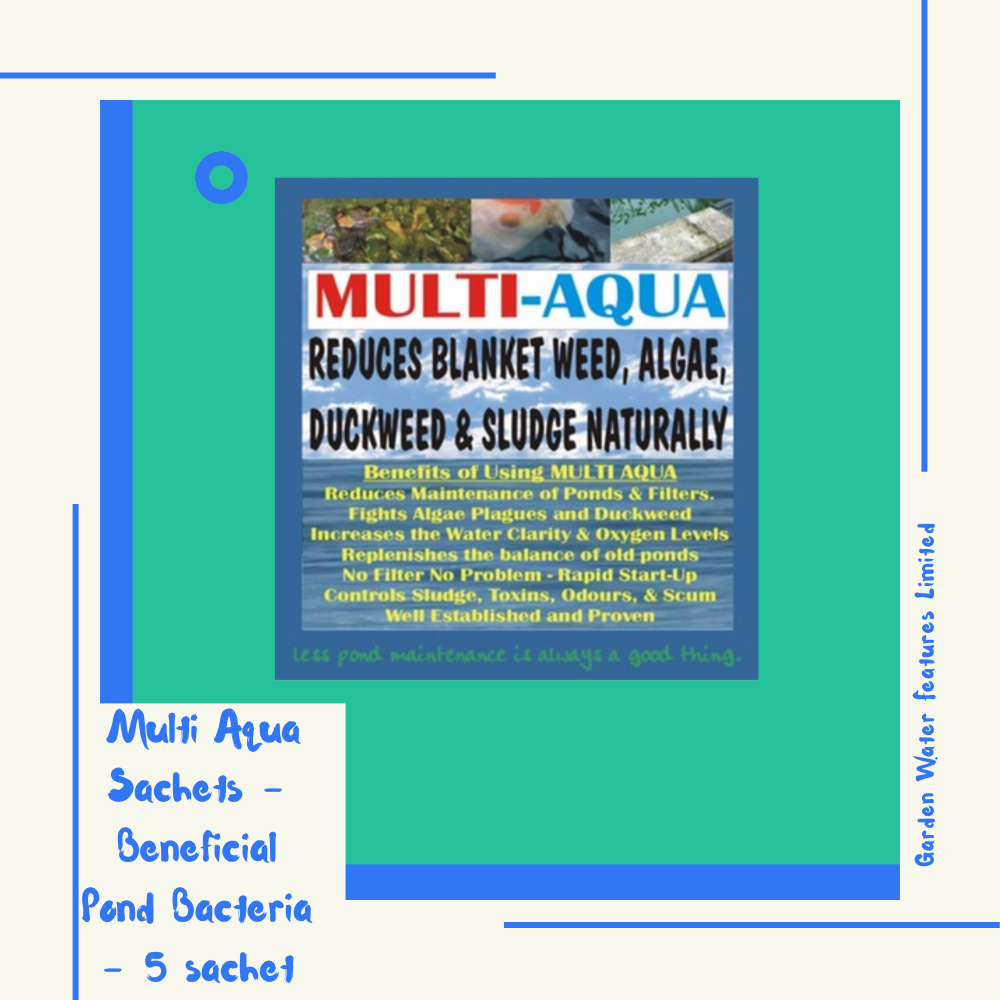Garden Water Features Limited
Beneficial Bacteria - Multi Aqua Sachets
Beneficial Bacteria - Multi Aqua Sachets
Couldn't load pickup availability
Introducing the Beneficial Pond Bacteria Multi-Aqua Sachets, your solution to maintaining a healthy and clean pond. These water-soluble sachets are packed with 14 different strains of professional-grade beneficial bacteria, designed to effectively reduce pond waste.
Key Features and Benefits:
- Comprehensive Waste Reduction: Each sachet contains premium strength bacteria, targeting blanket weed, algae, duckweed, and sludge naturally.
- Ideal for New and Mature Ponds: Perfect for kick-starting new ponds or replenishing mature ones, ensuring a balanced aquatic environment.
- Versatile Usage: Effective in a range of temperatures, from cold water under the ice to the warmest summer days.
- Safe and Eco-Friendly: 100% safe for pets, fish, and wildlife when used correctly, ensuring a healthy ecosystem for all inhabitants.
- Convenient Packaging: Available in various quantities, from single sachets to bags of 5 or 25, catering to ponds of all sizes.
- Easy Storage: Packaged in a clear, splash-proof bag for easy and dry storage away from sunlight.
- Effective Dosing: One sachet treats up to 4500 litres, suitable for both maintenance and reduction doses.
- Proven Formula: Developed in the US and now produced in the UK, backed by extensive research and development.
Transform your pond with Multi-Aqua Sachets, ensuring a clean and healthy environment for your aquatic life. Visit our information site or watch our YouTube videos for more tips and tricks on using Multi-Aqua Sachets.
Can you put too many beneficial bacteria in a pond?
Generally, it is difficult to "overdose" a pond with beneficial bacteria because these bacteria are naturally occurring and non-toxic. They play a crucial role in balancing the pond's ecosystem by breaking down organic waste, such as fish excreta, dead plants, and excess nutrients, which can cause algae growth if left unchecked.
However, there are a few points to consider:
-
Balance is Key: While beneficial bacteria are safe, the key to a healthy pond is balance. Overloading the pond with too many bacteria at once can temporarily disrupt this balance. It's important to follow the recommended dosages and guidelines provided by the product manufacturer.
-
Oxygen Levels: Adding a large amount of bacteria to a pond can increase the biological oxygen demand as the bacteria work to break down organic matter. This could temporarily reduce the available oxygen for fish and other aquatic life, especially in ponds with limited aeration or high fish populations.
-
Cost-Effectiveness: Using more beneficial bacteria than needed can be cost-effective. It’s best to use the right amount for your pond's size and needs as per the product instructions.
-
Adjusting to Pond Conditions: Ponds with different conditions (like varying levels of organic matter, different sizes, and different fish populations) require different amounts of bacteria. It’s important to adjust the dosage according to your specific pond conditions.
-
Regular Maintenance: Regular maintenance, such as removing debris, maintaining good water circulation, and proper filtration, is also crucial for a healthy pond. Beneficial bacteria are a part of this maintenance but not a standalone solution.
In summary, while it's difficult to put too many beneficial bacteria in a pond, it's best to use them as per the instructions and in conjunction with overall good pond management practices. If you're unsure, it's always a good idea to consult with a pond management professional.
How often should I add beneficial bacteria to my pond?
The frequency of adding beneficial bacteria to a pond depends on various factors, including the size of the pond, the number of fish, the amount of plant life, and overall pond conditions. Here are some general guidelines:
-
Regular Maintenance: For most ponds, adding beneficial bacteria weekly is a common practice. This helps maintain a balanced ecosystem by continuously replenishing the bacteria that break down waste and nutrients.
-
New Ponds: For new ponds or after a significant clean-out or water change, it’s recommended to add beneficial bacteria to help establish the biological filtration. In these cases, a larger initial dose may be followed by regular, smaller doses.
-
Spring Start-Up: In spring, as temperatures start to rise and aquatic life becomes more active, it's advisable to add beneficial bacteria to kick-start the pond's ecosystem after the winter dormancy period.
-
After Algae Treatment: If you've recently treated the pond for algae, it's good to add beneficial bacteria afterwards. Algae treatments can disrupt the natural balance, and replenishing the bacteria can help restore it.
-
High Fish Populations: If your pond has a high fish population, you might need to add bacteria more frequently, as more fish means more waste, which requires more bacteria to break it down.
-
During Warm Weather: Beneficial bacteria can be more active in warmer temperatures, so you might need to add them more frequently during the summer months.
-
Following Heavy Rainfall: Heavy rain can dilute the pond’s bacteria levels and introduce additional nutrients and debris. Adding beneficial bacteria after significant rainfall can help rebalance the pond.
-
Manufacturer’s Instructions: Always follow the manufacturer’s instructions on the product you are using, as potency and formulation can vary.
-
Observation: Regularly observe your pond for signs of imbalance, such as water clarity issues or foul odours, which can indicate a need for additional beneficial bacteria.
-
Consistency is Key: Regular, consistent additions of beneficial bacteria are more effective than sporadic, heavy dosing.
Remember, each pond is unique, so it's important to adjust the frequency based on your specific pond's needs and conditions. Regular monitoring and adjustments are key to maintaining a healthy pond ecosystem.
How long does beneficial bacteria take to clear a pond?
The time it takes for beneficial bacteria to clear a pond can vary depending on several factors, including the size of the pond, the initial condition of the water, the load of organic matter present, and environmental conditions like temperature and oxygen levels. Here are some general points to consider:
-
Initial Water Quality: If the pond is heavily polluted with a lot of organic waste, and algae, or has poor water quality to begin with, it will take longer for beneficial bacteria to have a noticeable effect.
-
Pond Size and Depth: Larger and deeper ponds will naturally take more time to clear than smaller, shallower ones.
-
Water Temperature: Beneficial bacteria are more active in warmer temperatures. Hence, they work faster during the warmer months of spring and summer. In colder temperatures, their activity slows down, leading to a longer time frame for clearing the pond.
-
Aeration and Circulation: Ponds with good aeration and water circulation allow for more effective distribution of bacteria, which can speed up the process of cleaning the water.
-
Regular Maintenance: Regular dosing as per the product instructions and maintaining good pond practices, like removing debris and ensuring proper filtration, will support the bacteria’s effectiveness.
-
Bacterial Strains and Concentration: Different products contain different strains and concentrations of bacteria. High-quality, professional-grade products may work more efficiently.
In general, it may take a few weeks to several months to see a significant improvement in water clarity and quality. It's important to have realistic expectations and understand that beneficial bacteria work as part of a long-term solution rather than a quick fix. Continued use and regular maintenance are key to achieving and maintaining a clear, healthy pond.
Does beneficial bacteria work in ponds?
Yes, beneficial bacteria are highly effective in ponds and play a crucial role in maintaining a healthy aquatic ecosystem. Here's how they work and why they are important:
-
Breaking Down Organic Waste: Beneficial bacteria break down organic matter in the pond, such as fish waste, dead plant material, and excess food, which can otherwise lead to poor water quality and algae blooms.
-
Reducing Nutrients: By decomposing organic waste, these bacteria help reduce the nutrients in the water, particularly nitrogen and phosphorus, which are key contributors to algae growth.
-
Improving Water Clarity: As beneficial bacteria break down organic matter, they help improve water clarity by reducing the amount of suspended particles in the water.
-
Balancing Nitrogen Cycle: Beneficial bacteria are essential for the nitrogen cycle in the pond. They convert harmful ammonia released from fish waste into nitrites and then into nitrates, which are less harmful and can be used by plants as nutrients.
-
Reducing Sludge: Over time, these bacteria can help reduce the buildup of sludge at the bottom of the pond by breaking down organic debris that settles there.
-
Supporting Overall Health: A healthy population of beneficial bacteria is key to a balanced ecosystem, supporting the health of fish and plants and reducing the likelihood of water quality issues.
-
Natural and Safe: Using beneficial bacteria is a natural approach to pond maintenance. Unlike chemical treatments, they are safe for fish, plants, wildlife, pets, and the environment.
It's important to note that while beneficial bacteria are effective, they are part of an overall pond management strategy that includes proper filtration, aeration, regular cleaning, and appropriate feeding practices. For best results, it's crucial to use the bacteria as directed and maintain consistent pond care habits.
Why can't I just leave the pond alone?
Beneficial bacteria work in ponds by performing essential functions that contribute to a balanced and healthy aquatic ecosystem. Here's a breakdown of how they work and why relying solely on natural processes without any intervention might not always be sufficient for a well-maintained pond:
How Beneficial Pond Bacteria Work:
-
Decomposing Organic Matter: Beneficial bacteria break down organic waste like fish excrement, dead plants, and uneaten fish food. This decomposition process prevents the accumulation of harmful substances and keeps the water clean.
-
Nitrogen Cycling: These bacteria are crucial in the nitrogen cycle. They convert harmful ammonia (produced from fish waste and decaying matter) into nitrites and then into less toxic nitrates. Plants can utilize nitrates, but high levels can be harmful, so regular monitoring is essential.
-
Reducing Algae Growth: By consuming excess nutrients in the water, beneficial bacteria help control algae blooms. Algae often thrive in nutrient-rich waters, so reducing these nutrients can naturally limit algae growth.
-
Improving Water Quality: Through their actions, beneficial bacteria help maintain clearer water and a healthier environment for fish and plants.
Why Not Just Leave the Pond Alone?
-
Overloading of Nutrients: In a closed system like a garden pond, nutrient levels can quickly become imbalanced due to fish waste, decaying organic matter, and runoff from the surrounding environment. This can lead to excessive algae growth, poor water quality, and unhealthy conditions for fish and plants.
-
Limited Natural Bacteria: While ponds naturally contain beneficial bacteria, their numbers might not be sufficient to handle the load of waste and nutrients, especially in artificial or heavily stocked ponds.
-
Oxygen Levels: Decomposition of organic matter consumes oxygen. Without adequate aeration and bacterial action, the oxygen levels in the pond can drop, stressing or even killing fish and beneficial microorganisms.
-
Buildup of Harmful Substances: Without enough beneficial bacteria, harmful substances like ammonia and nitrites can accumulate to toxic levels, posing a threat to aquatic life.
-
Sludge Accumulation: Over time, organic debris can accumulate at the bottom of the pond, forming sludge, which can harbour harmful pathogens and reduce water quality.
While it's true that ponds can to some extent self-regulate, human intervention is often necessary, especially in man-made or heavily stocked ponds, to maintain a healthy balance. Adding beneficial bacteria is a natural way to enhance the pond's ability to self-regulate, ensuring a healthier and more stable environment for its inhabitants.
Have any of these questions?
How to use
How to use
Shipping
Shipping
Our shipping fees apply to UK residents. If you're further afield then reach out to us with your order, then dispatch cant calculate the shipping fees
Return policy
Return policy





Hand Feed Your Pond Fish
Watch this video to learn how.





